

In a time not so long ago, in a place not so far away, the idea of getting “away from it all” meant heading into the outdoors to be removed from the daily grind and all its fixtures. Leaving the office and daily distractions at home to have an adventure in the great wide world was how the weekend warrior found reprieve, but things have changed quite a bit. The notion of taking a break doesn’t apply to our electronics, and even while camping in the woods it’s possible to stay connected to the world with our trusty devices.
For RVers especially, outdoor exploration comes with the additional luxury of refrigeration, heating, air conditioning, microwave ovens and other niceties that require electricity, which is where portable generators come into play.
If you’re in the market, a Google search for “portable generator” will return a deluge of machines: some big, some small, some with multiple fuel options and various wattages all with the sole purpose to deliver remote electricity. But what is the best portable generator? Well, that all depends on the application, and when factoring portable generators for RV use into the mix there is an added layer of complexity. The Pulsar lineup of portable generators covers the spectrum of use-cases to provide power in any circumstance.
What is a Portable Generator Useful for?
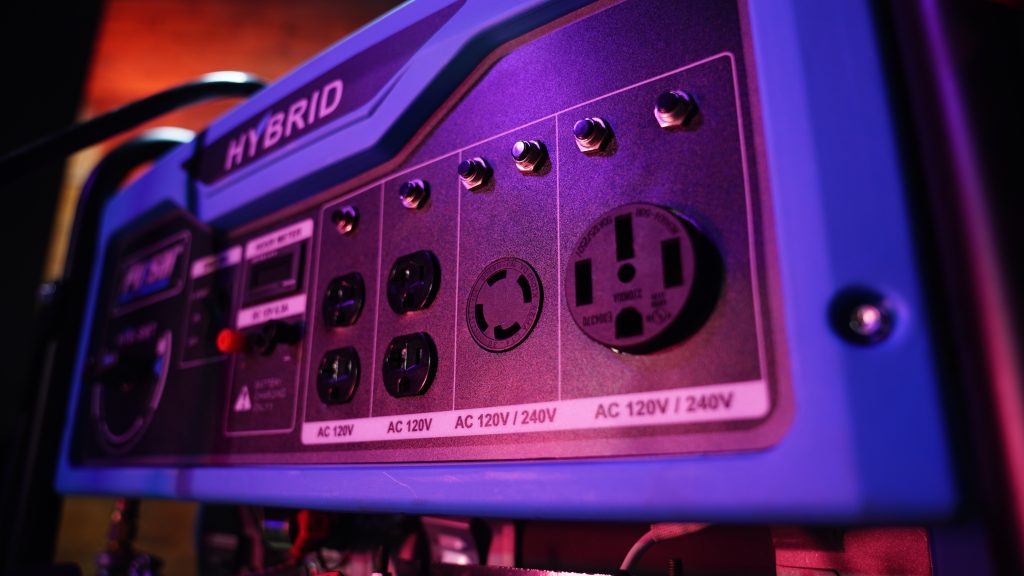
I never fancied myself much of an RV person until my dad and I took his 18’ RV hunting in the Idaho backcountry. We had a 2000W inverter generator running the microwave, lights, charging phones and GPS units, playing music; it was a great experience being outdoors with all the creature comforts of home.
That trip opened my eyes to the world of travel with remote power, and it only scratched the surface of RV camping with a portable generator. More serious fans of luxury road travel can power everything from hot water heaters, air conditioners, crock pots and TVs to anything else. The best part of bringing a portable generator is the ability to power these devices anywhere, from remote campsites or job sites to parking lots for tailgate events.
While there’s plenty of fun to be had with generators, arguably their most important role is to provide emergency electricity for home backup power during a natural disaster or power outage.
One of the critical flaws for people in natural disasters is being unprepared (here are our tips for emergency preparedness), and when you actually need backup power it’s usually too late to go out generator shopping.
While home backup generators are always a good idea for those in volatile regions, a portable generator is the best option for most homes for power outages. Portable generators offer more versatility than their stationary counterparts because they offer a use beyond the rare occasion when homes lose power. Major storms that cause power loss might happen once or twice a year and generators purchased as a long-term precautionary measure might never get called into action. If you have a stationary unit, that doesn’t offer much value in any other scenario.
Portable generators can be used in a wide variety of settings, so their utility is extended beyond strictly emergency use to an all-around power option.
What Is an “RV-Ready Generator”?
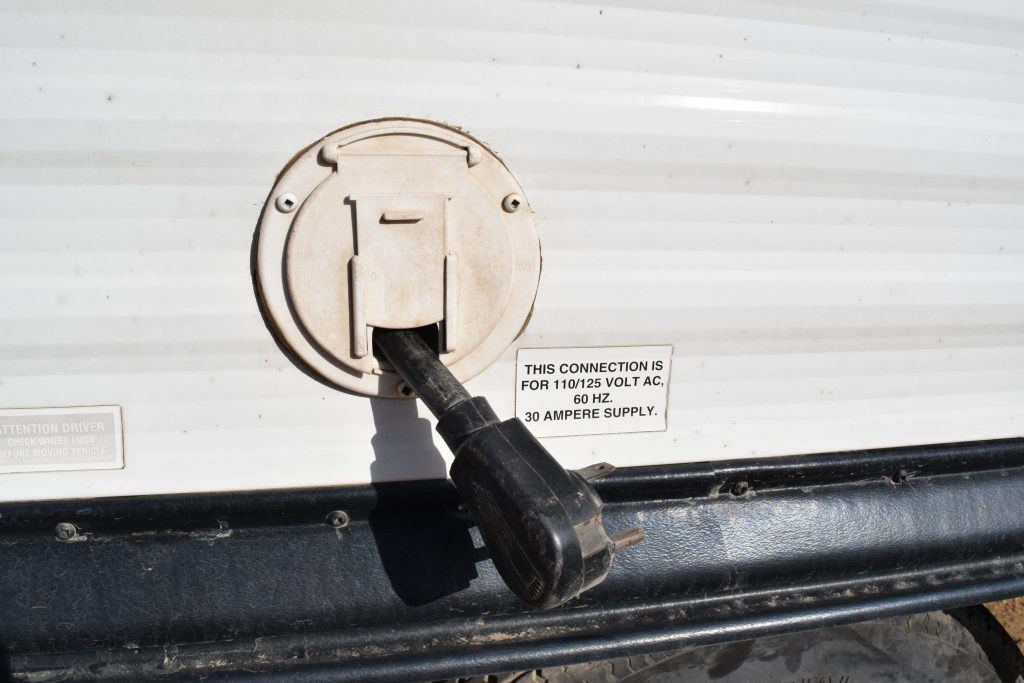
One of the phrases that comes up when searching for a portable generator is “RV-ready”, which is inherently important to anyone with an RV. For a generator to be RV-ready it needs to simply have the correct style twist-lock 30A outlet to deliver 30A of power, which is a standard RV power requirement. Some large RVs require 50A service to power all their goodies, but 30A is the baseline. In most cases, the 30A twist-lock style will need an adapter to be compatible with the plug from the RV.
RV-ready generators also often have the TT-30R RV outlet for 30A service, which is a direct fit with the plug from the RV to power the entire rig with all devices. This is the same outlet that is available at RV hookup sites when you just pull up and plug in for power to get everything running within the vehicle.
For those with onboard climate control, RV air conditioner units are frequently around 13,500BTUs, which are pretty heavy-duty appliances with greater power requirements. Depending on the size and quantity of the current demands of all the electronics, one RV-ready portable generator may not be suitable for all applications.
What is the Best Quiet Generator for Camping?
One of the less-rigid qualifications for an RV-ready portable generator or any camping generator should be the noise consideration. The expectation is that since users won’t be in a loud environment like a construction site, maintaining some semblance of peace and quiet or at least being able to hold conversations while the engine is running is a critical component.
A rough estimate of somewhere between 60-70 dB is a good measure of what an RV generator should put out in terms of noise pollution. Especially when taking into account running devices like air conditioners on warm summer nights or potential neighbors, you would want something that doesn’t make it impossible to sleep or enjoy where you are.
Generally as the size of the portable generator grows so does the noise production, so there is a trade-off between the two that comes into play as well.
Pulsar and Generator Harmony
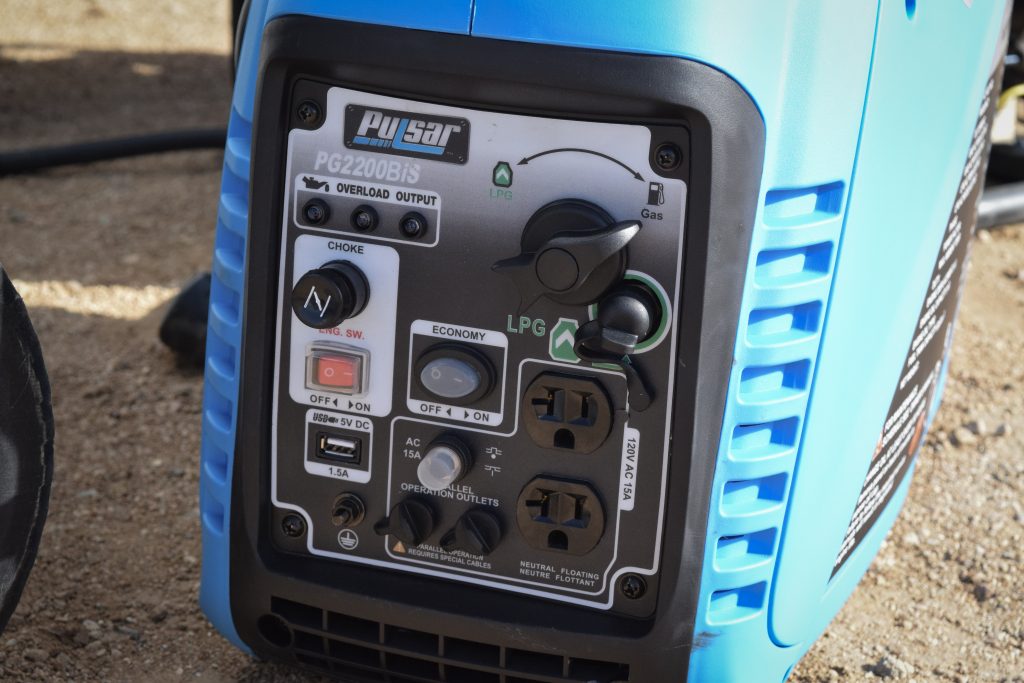
Pulsar Products is a portable generator (as well as pressure washer and compressor) manufacturer out of Ontario, CA that has a variety of models that span a wide range of power outputs.
Their position in the market is targeted to be significantly more cost-efficient than the Honda or Yamaha generators, but with similar performance. One of the key elements of their generators is quality, which they have optimized through delivery of “clean electricity” with the lowest possible total harmonic distortion (THD).
The lower the THD, the more stable the power is and safer for sensitive electronics. Using sensitive devices with high THD generators can cause damage and a reduction in service life. Typically, generator electricity is considered “clean” or having a stable sine wave if the THD is under 5%.
Pulsar’s design specs for their traditional open-frame generators is ≥ 5% THD, while their inverter generators are ≥ 3%, which means that they are well in the realm of energy quality classification for “clean electricity”.
There’s plenty more to explore with generator sine waves and THD for those so inclined, but a couple key points to consider about THD when choosing a portable generator from PowerUpGenerator.com:
- Low-quality power is acceptable for intermittent use for power tools and most appliances. (THD less than 10%)
- Higher quality power is required as the sensitivity of devices or duration of use increases. (THD 6% to 9%)
Inverter Generator vs Traditional Generators
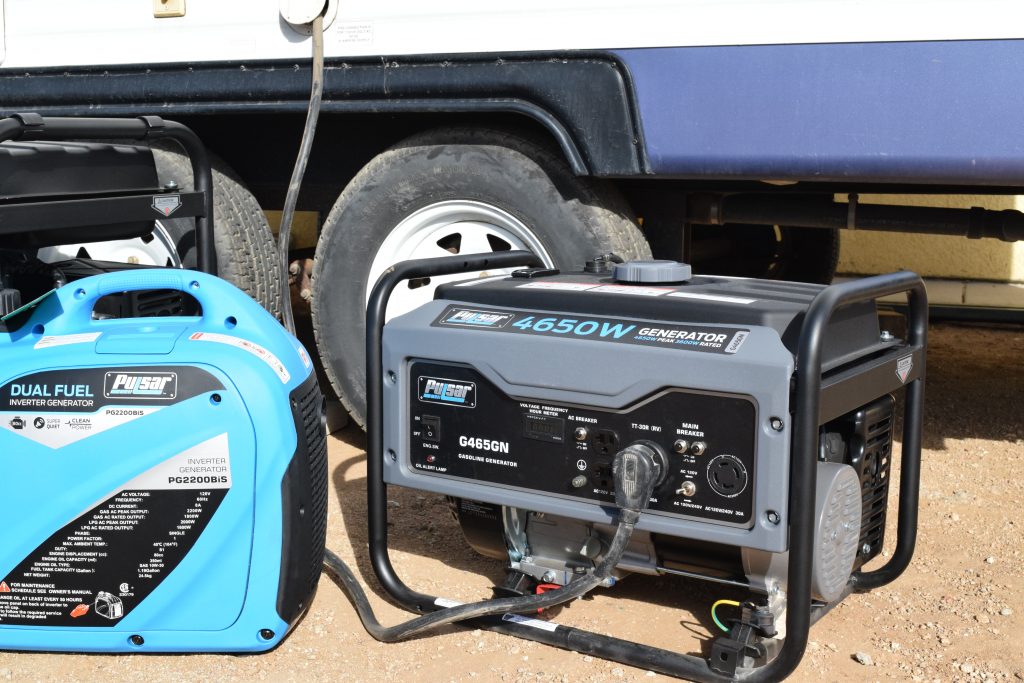
A key feature that comes up when searching for portable generators is the “inverter” classification. But what exactly is the difference between an inverter generator and a traditional generator?
Stable Power
The primary difference is inverter generators have a clean or stable sine wave. What that means is that they are safe for sensitive electronics like cellphones, laptops, etc (running a TV you won’t get a line across the picture, and audio equipment won’t have noise)
Quieter Operation
Inverter generators are totally enclosed, with sound deadening panels which helps to keep the noise down and the operation itself is often much quieter than traditional gas generators
Greater fuel efficiency
Most inverter generators have an “eco” or “economy” mode, which means that they will adapt engine speed automatically to the power demand, so they are not running in excess what is needed and using extra gas
On the flip side, traditional generators are usually about 1/3 the price of inverter generators of equal power. For those not looking to power sensitive electronics (for construction use or large appliances), traditional open-frame generators offer a great budget buy option.
Also, from a repair perspective, open-frame generators are easier for owners to access and either fix themselves or take to a local repair shop, while inverter generators are more complex and require special skill to work on.
What Fuels Your Power
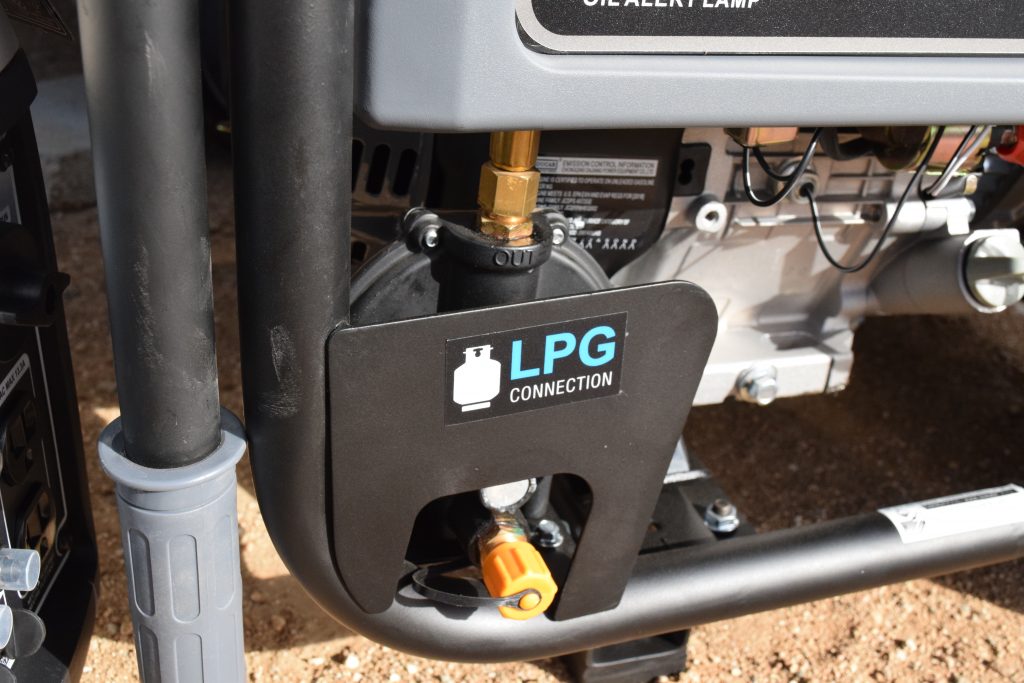
Portable generators (both for RVs and otherwise) either come in gasoline or dual-fuel options, while large, stationary generators can run on diesel fuel or natural gas. The fuel source makes a difference when weighing the option of dual-fuel generators, which can run off either gasoline or propane power.
Gasoline provides the maximum power output for portable generators, and for semi-regular to regular use it makes the most sense since the gasoline is cycled regularly. If you plan on using it solely for emergency situations though and don’t have gasoline around for other applications, storing gasoline for extended periods of time isn’t a great idea, since old gas is not good for the equipment.
For dual-fuel models, propane has about 90% of the energy potential of gasoline, however it will store indefinitely without degredation or risk of damage to your generator.
Having the dual-fuel option is also good for emergency backup situations when camping since the portable, 1lb Coleman-type propane bottles can be used in a pinch if the gasoline or bulk propane runs out.
One really useful characteristic of dual-fuel generators is their ability to run off any propane source, so not just the small portable tanks. For folks that use propane instead of natural gas, that means your 120-500 gallon propane tank can be connected to the portable generator for power with a fuel source you already have readily available.
The Pulsar Portable Generator Lineup
PG2000is 2000W Inverter Generator
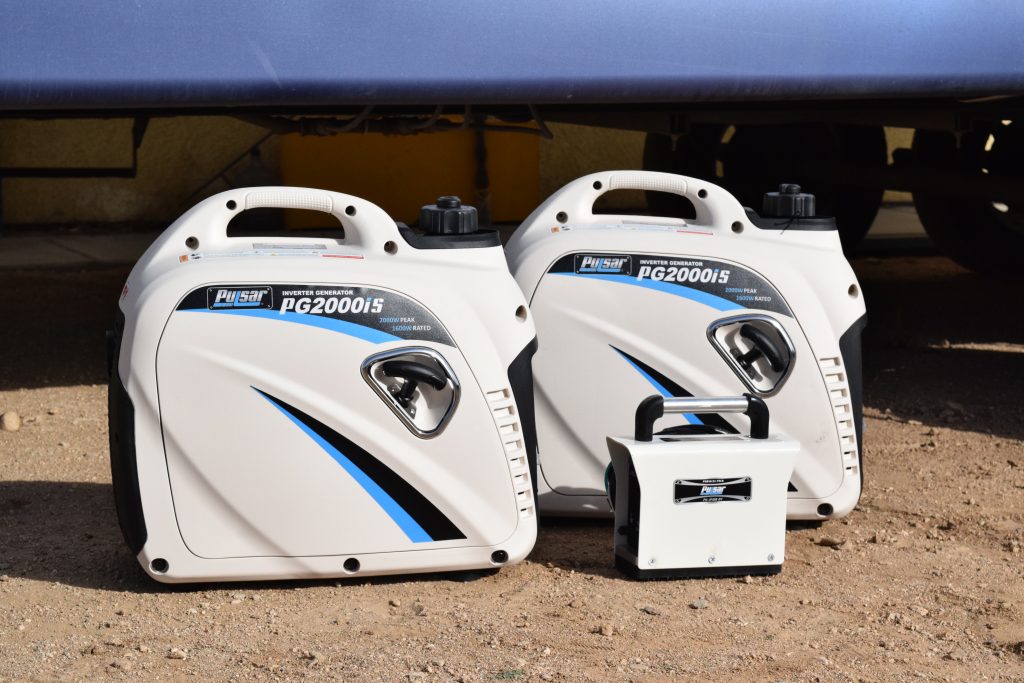
- Size/power
- 2000W peak
- 1600W rated
- 80cc OHV engine
- 19.7” x 11.2” x 17.9”
- Fuel source & tank size
- Gasoline, 1.18gal
- Cost
- $350
- Noise
- 59 dB
- Run time
- 8hrs at normal half-load
- Outlets
- 2 x120V outlets
- 1 x12V CLA outlet
- 1x 5V USB
At 40lbs, this is designed to be lifted in and out of a truck bed or trunk and move around with only one hand. This inverter generator is enclosed, which keeps the noise down but also protects the innards during transportation.
The 2000is only requires easy pulls to get the unit started, features a low oil indicator light and automatic shutoff when low oil level is detected, as well as an overload warning light. The downside of this unit from an RV perspective is that it doesn’t come RV-ready with a 30A outlet out of the box, so a converter is needed.
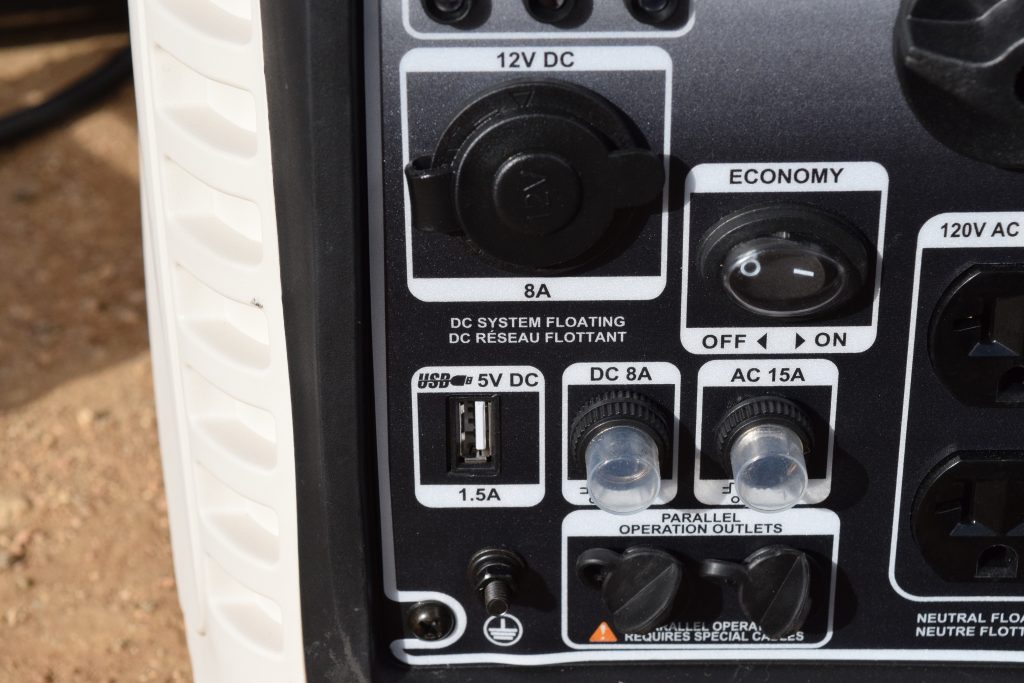
This unit does have “Economy Control”, and when this is turned on the unit automatically determines the generator’s proper engine speed based on the connected electrical load. This is designed to optimize the fuel consumption and noise reduction since you won’t need the unit to run at even half-load all the time.
Since generators are usually used outdoors in dirty settings, the white color will likely get sullied quite quickly. Pulsar decided to launch their PG2000ISN, which is the exact same model in a grey color to have something that would camouflage staining, which makes sense. Personally, the color isn’t a big consideration when generator shopping but having something dark would be nice to resist discoloration.
This 2000W model also has parallel capability and is available in a two-pack with the parallel kit, which can be quite useful.
Parallel Inverter for Portable Generators
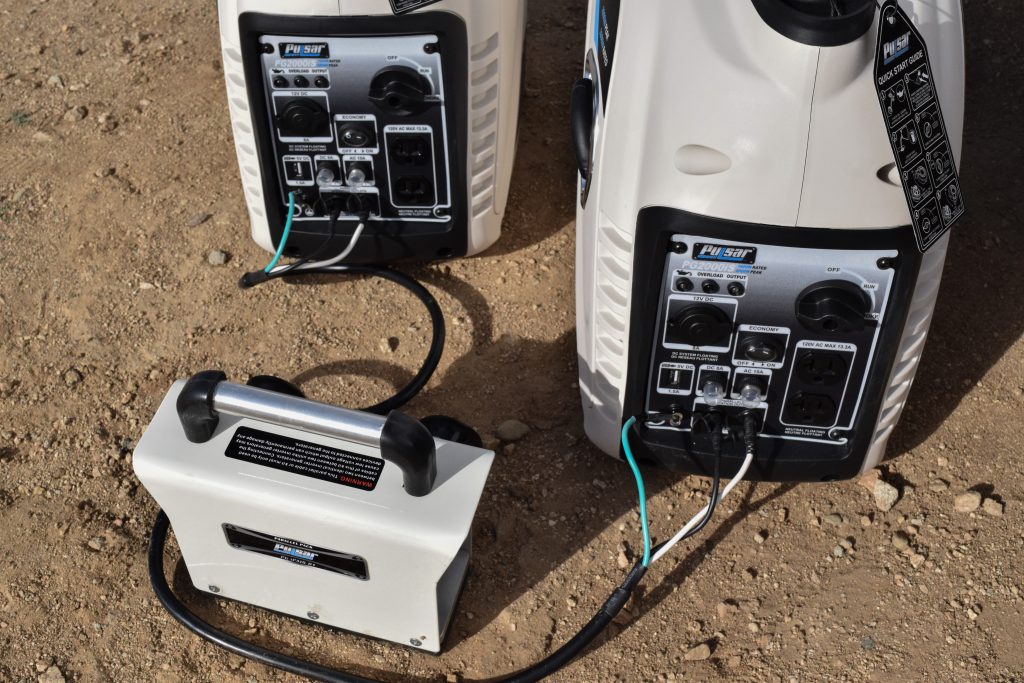
A parallel inverter kit for portable generators acts as a link to tie two inverter-type generators together to increase the available power output.
This doubles the power output of your generator setup, meaning that you can use a single device that draws more current than one entire generator can produce.
The parallel kit distributes the energy load between two units, however it is not able to tell what power capacity each unit is so the energy pull is distributed evenly between the two units. It is highly recommended to have two generators with the same wattage, to ensure safe operation and longevity of the equipment.
Traditional open-frame (non-inverter) generators cannot be paralleled because they do not have strict digital synchronization of the power output.
The $40 Pulsar inverter kit features both TT-30R RV and twist-lock outlets, so it can link up two of their PG2000IS(N) models together to have an RV-ready setup and is also compatible with their 4000W model.
Benefits of Parallel Generators
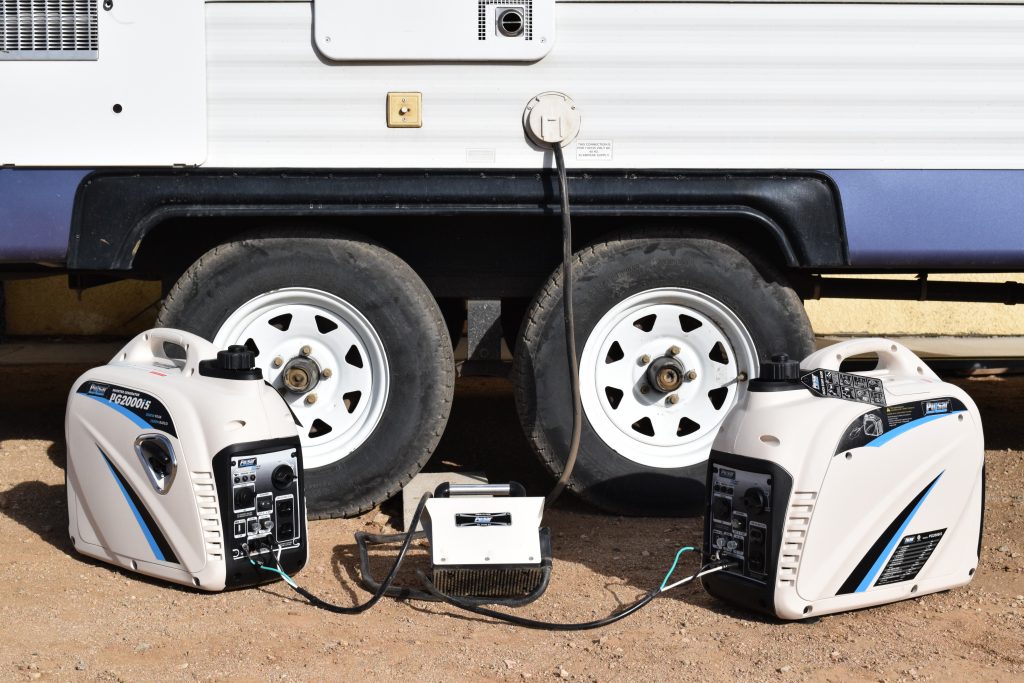
One main reason people opt for parallel-capable generators is being able to segment the power how you need it, like building blocks. When you need a little power, bring one. When you need more power, bring them both and parallel them together to increase available power.
A regular 2000W portable generator might be fine running a handful of devices like a fridge, some lights, and random electronic charging, but in disaster situations that might not be sustainable to run a high-BTU air conditioner, or powering the whole home with multiple appliances.
Generators are only supposed to be paralleled when they are designed in such a manner. Aside from the necessary cables and ports to connect them together, paralleling generators requires both units to be of the same specification.
PG4000ISR 4000W Inverter Generator
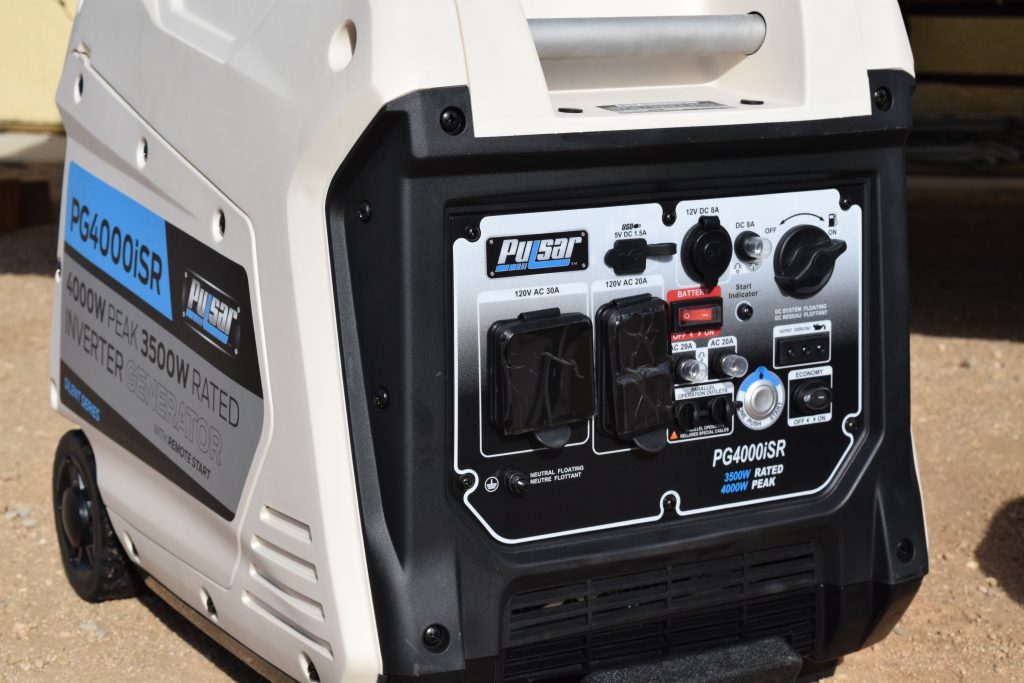
- Size/power
- 4000W peak
- 3500W rated
- 224cc OHV engine
- 21” x 20” x 30”
- Fuel source & tank size
- Gasoline, 3.5 gallon
- Cost
- $750
- Noise
- 63 dB
- Run time
- 15 hours at half-load
- Outlets
- 1 x 30A RV
- 2 x 120V
- 1 x 12V 8A
- 1 x 5V USB
The PG4000ISR has 5.5” wheels, with a telescoping spring-loaded handle for helping to cart the unit around, and at 92.6lbs it is getting to the heftier end of the portable generator scale.
This unit is altogether on the larger side and requires two people to lift it out of a truck bed. The wheels are great for moving it around once on flat land, and a unit of this size can be enough to power a larger RV or even some lighter construction job sites.
The 4000W generator is designed for maximum ease of use with high power output, with a push-button electronic start (no pull cord necessary) and comes RV-ready with the TT-30R RV outlet.
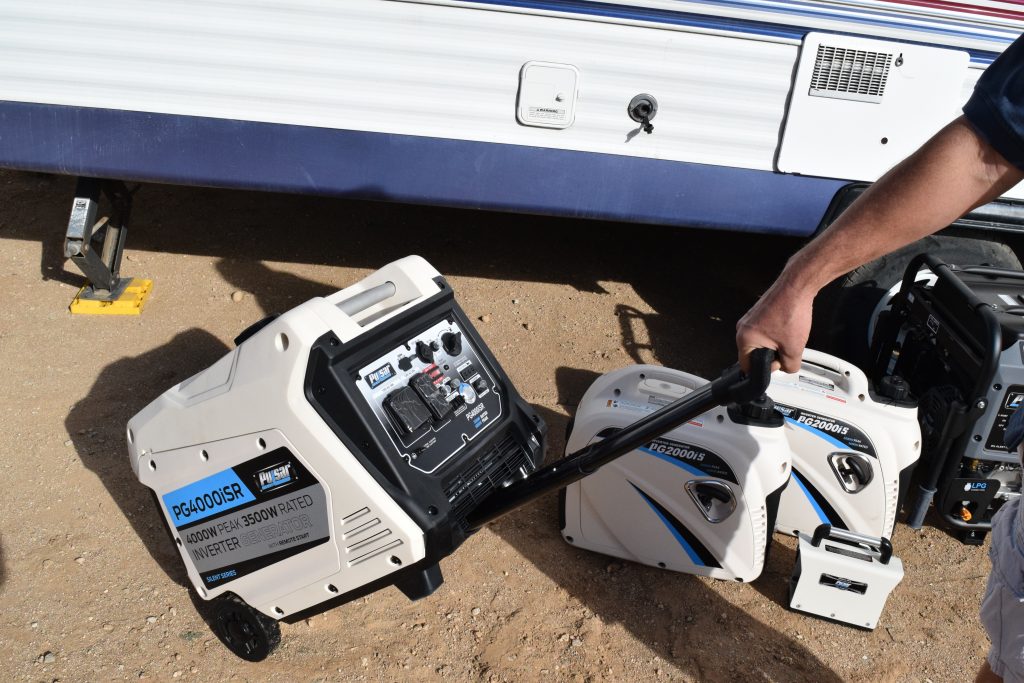
One of the unique things about this model is the remote for use to start or stop it from inside a camper which is awesome. Having experienced hopping out of a snuggly RV camper at 4am in 27° weather to fire up the generator with several pulls at a cold start, I can say that this is an awesome feature.
If needed, this model can be used with the parallel kit, to ramp up the power production even more if needed, and it also comes with all the features like a DC power port, oil warning light, automatic shutoff, overload indicator, and economy mode.
G4650GN 4650W Traditional Generator
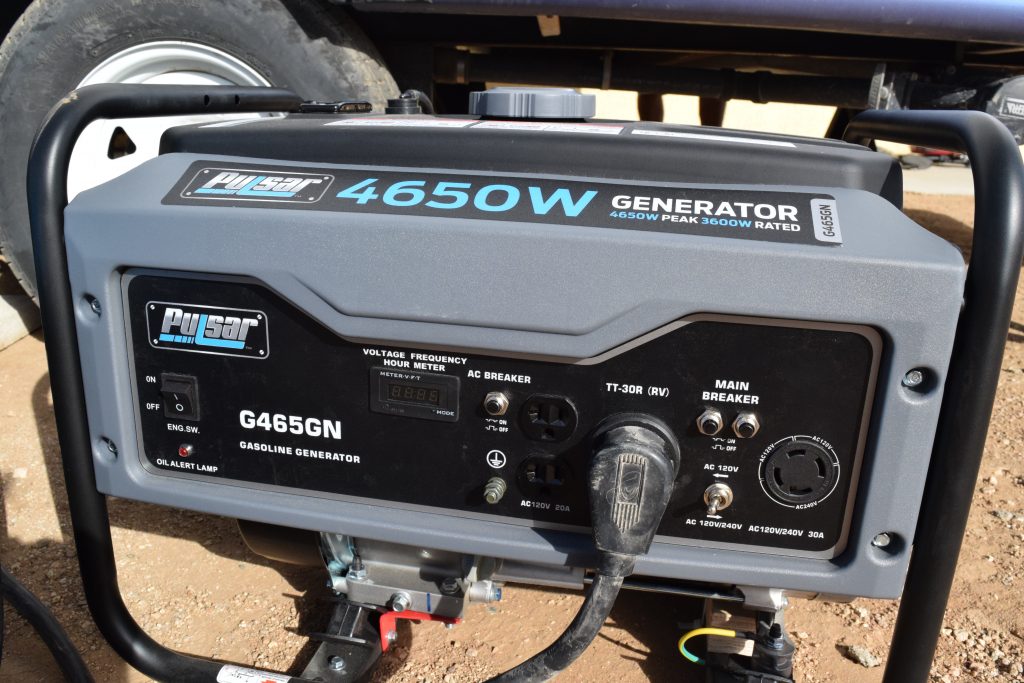
- Size/power
- 4650W peak
- 3600W rated
- 19.7” x 17.9” x 24”
- 208cc OHV engine
- Fuel source & tank size
- Gasoline, 4gal
- Cost
- $280
- Noise
- 70 dB
- Run time
- 11 hours on a half-load
- Outlets
- 1 x 120V Duplex
- 1 x TT-30R RV
- 1 x 120/240v 30A twist lock
This unit is easy enough to lift with two people and transport, however it doesn’t have a set of wheels like the larger inverters in the lineup.
There is a “mobility kit” which can be purchased for $40 that includes a handle, front stand and 8” hardened “never flat” wheels which greatly improves the portability of the 103lb machine.
This open-frame generator comes with a built-in 3-in-1 meter which shows voltage, frequency and hour information on an LED screen which is helpful. It also has a voltage selector switch and automatic voltage regulation, along with an AC circuit breaker, oil warning light, automatic shutoff, and overload indicator.
G12KBN 12,000W Traditional Generator
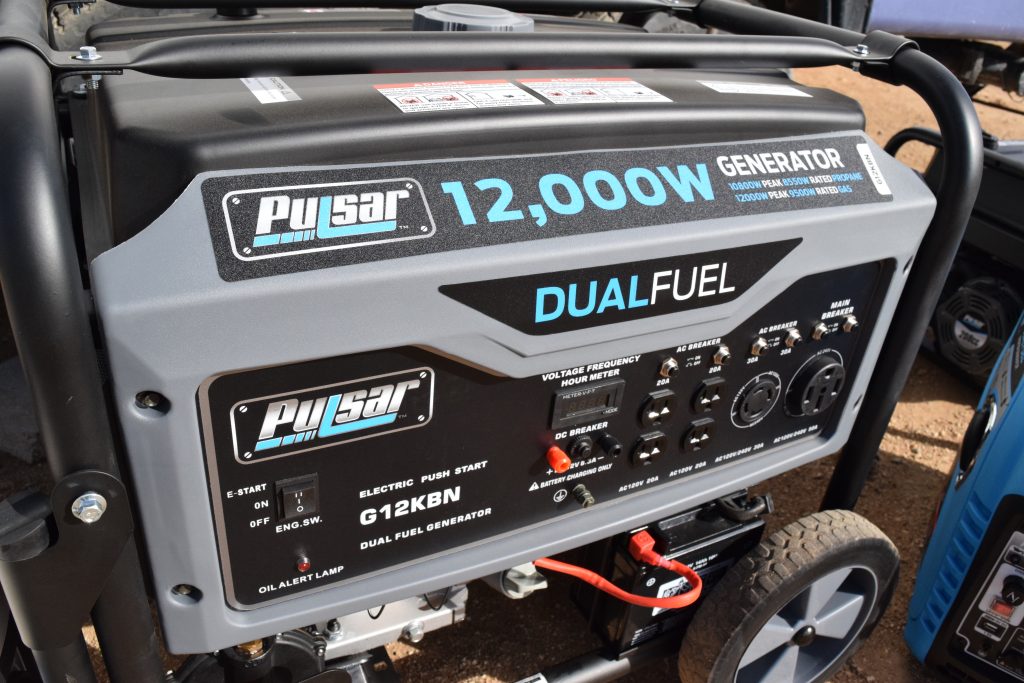
- Size/power
- 12,000W peak/9,500W rated gas
- 10,800W peak/8,550W rated propane
- 457cc OHV engine
- 28.5” x 26” x 25.5”
- Fuel source & tank size
- Dual-fuel (LPG and gasoline), 8gal
- Cost
- $1,100
- Noise
- ~75 dB
- Run time
- 12hrs at half-load on gas
- Outlets
- 4 x 120V 20A
- 1 x 120V/240V 30A twist-lock
- 1 x 120V/240V 50A
- 1 x 12V
The behemoth of the Pulsar lineup, and pushing the limits of the word “portable”, the 12,000W unit surpasses their previous 10,000W Dual-Fuel Switch-N-Go to take the cake as the highest output generator in this class.
Part of the reason Pulsar developed this model was to address the trend of customers underestimating their power needs. While this is always good practice so you don’t hit the power ceiling when you need it, they noticed that customers were snatching up the most powerful units they could get.
This beast is designed for maximum power and comes RV-ready with the twist-lock outlet as well as a 50A receptacle. The 12,000W unit has electric start, as well as a built-in 3-in-1 meter which shows voltage, frequency and hour information on an LED screen which is helpful. It also has an automatic voltage regulation, along with both AC and DC circuit breakers, an oil warning light, automatic shutoff, and overload indicator.
At 214 lbs, this is most definitely a two-person job for lifting, although the 10” never-flat wheels and heavy-duty handles help to make this thing actually a portable generator. I was able to use a couple boards as ramps to roll the machine up into the bed of my truck when I pulled down to the end of the driveway and got a little momentum going, but this is a beefy unit.
Do You Need Home Standby?
While many of these generators are RV-ready, and any generator can be used to run specific electrical devices within the home, few are actually capable of home standby application. This is found on larger generators like the G12KBN, which have 50A service outlets and 240V capacity to power critical equipment throughout the entire home.
These types of units can connect to the home circuit breaker panel with an auto transfer switch, so in the event of a power outage at home the unit can be started and critical electronics within the home will work just as usual.
In the case of the 12,000W unit from Pulsar, you get the best of both worlds between a large stationary unit and a portable generator.
Will a Portable Generator Run My…
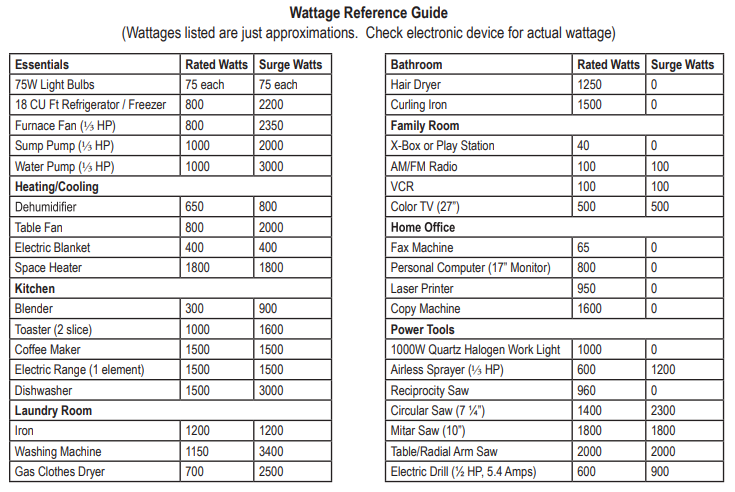
While there are many questions that come into play when searching for a portable generator (for RV use or otherwise), one of the most important is determining what the power requirements are for running your desired electrical devices.
First of all, it is important to note the difference between peak wattage and rated wattage. If you note in all the generator specs online and on most of the units themselves, you will see the two power notations.
Rated watts or rated power is the normal operating power the generator can produce. This is the sustainable amount of power you can rely on having as long as the generator is running.
Peak power or peak wattage is the maximum amount of power that the unit can produce for a very short amount of time. This is the ceiling of power that can be drawn from electronic devices during startup, which is known as the surge watts, (excess in wattage that electronics have for the first 2-3 seconds after powering on).
Here’s a quick list of how to calculate how many watts you need from a portable generator, from Pulsar:
- Add up the total rated wattage of all electronic devices that will be connected to the generator simultaneously.
- Estimate surge watts by adding the item(s) with the highest output (it is unnecessary to calculate the surge output for all devices as they should be connected one at a time).
- Add the Surge Watts to the total Rated Watts in step 1. Keep the total load within generator’s power capacity
For a worksheet to help calculate how much power you need, you can download one here.
Featured in this article:
Pulsar PG2000is 2000W White Inverter Generator- $350
Pulsar PG2000ISN 2000W Grey Inverter Generator- $350
Pulsar Parallel Inverter Kit- $40
Pulsar PG2000is 2000W White Inverter Generator 2pk w/Parallel Kit- $800
Pulsar PG4000ISR 4000W Inverter Generator- $750
Pulsar G4650GN 4650W Traditional Generator- $280
Pulsar 10,000W Dual-Fuel Switch-and-Go Traditional Generator- $800
Pulsar G12KBN 12,000W Dual-Fuel Traditional Generator- $1,100
“Note, all prices and products are accurate at the time of article publication, although some may have changed or are no longer available.”
